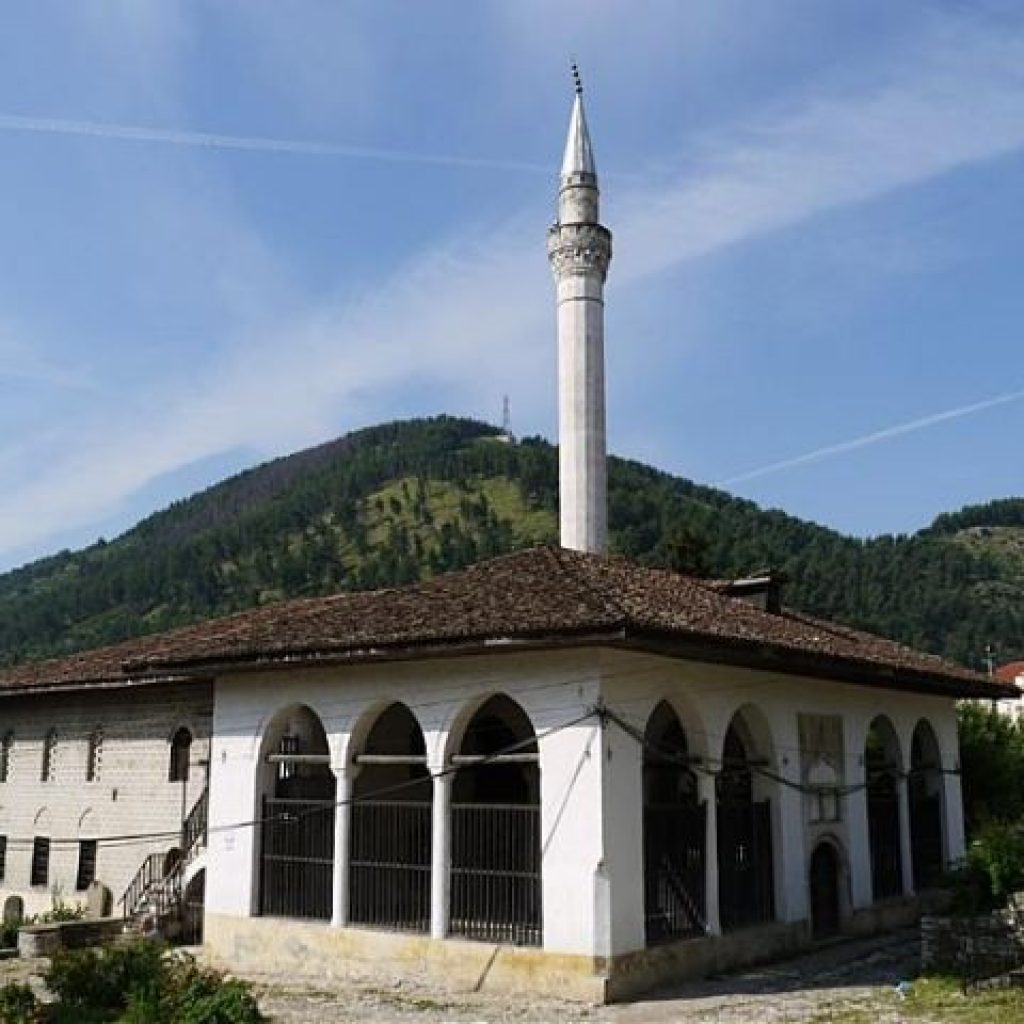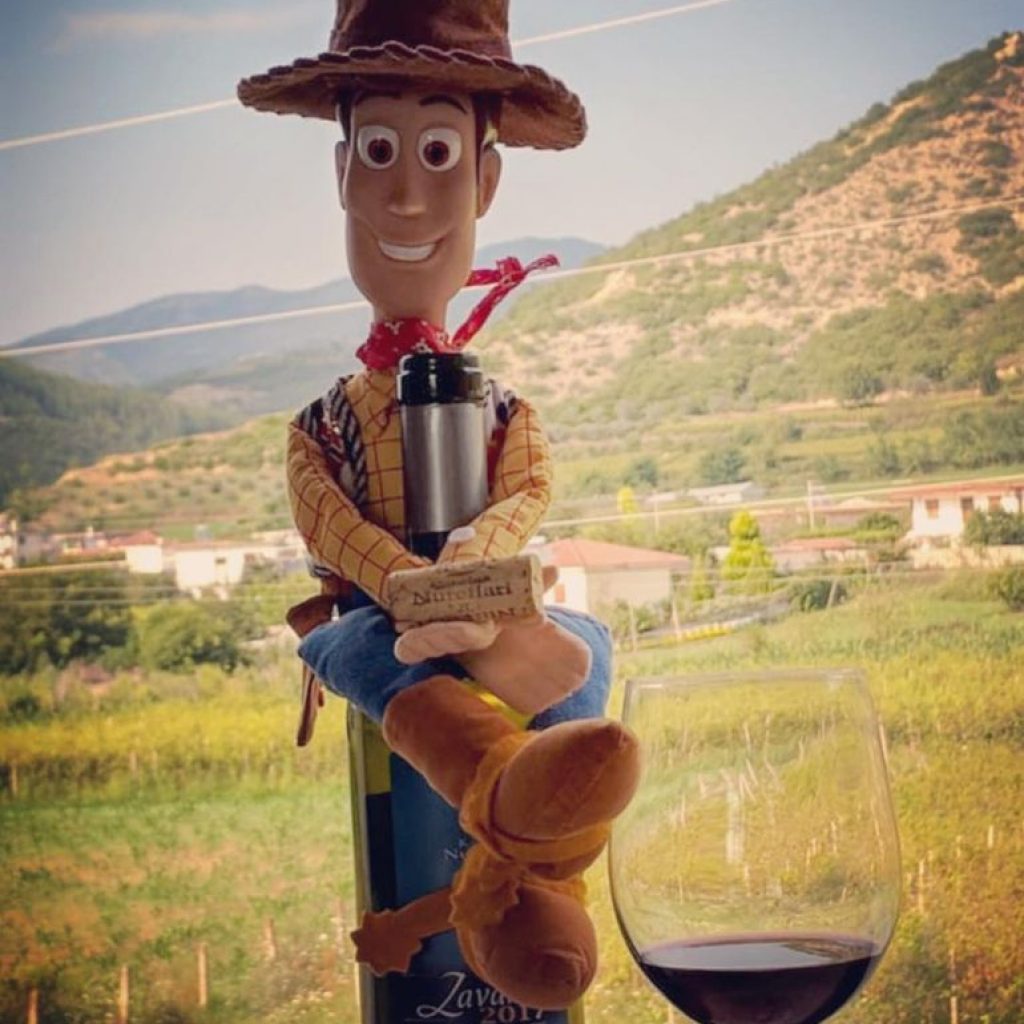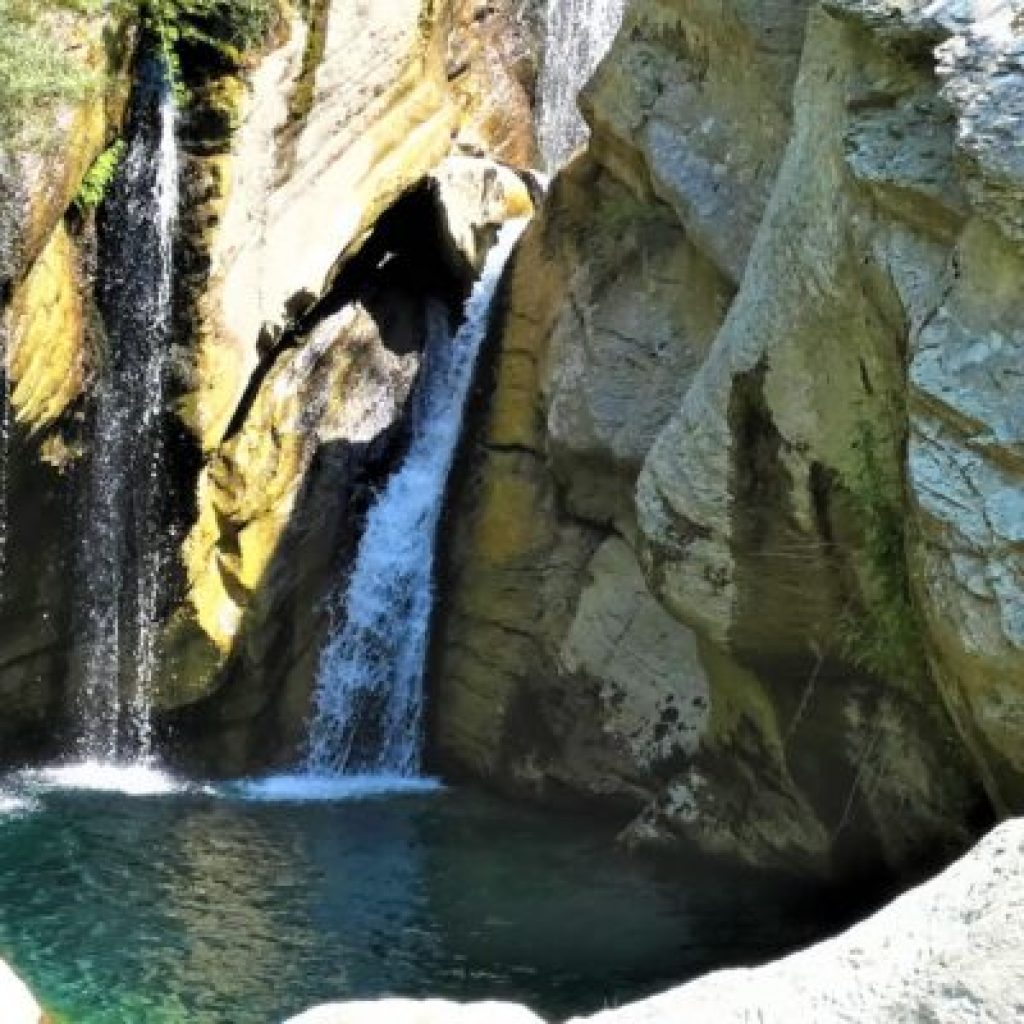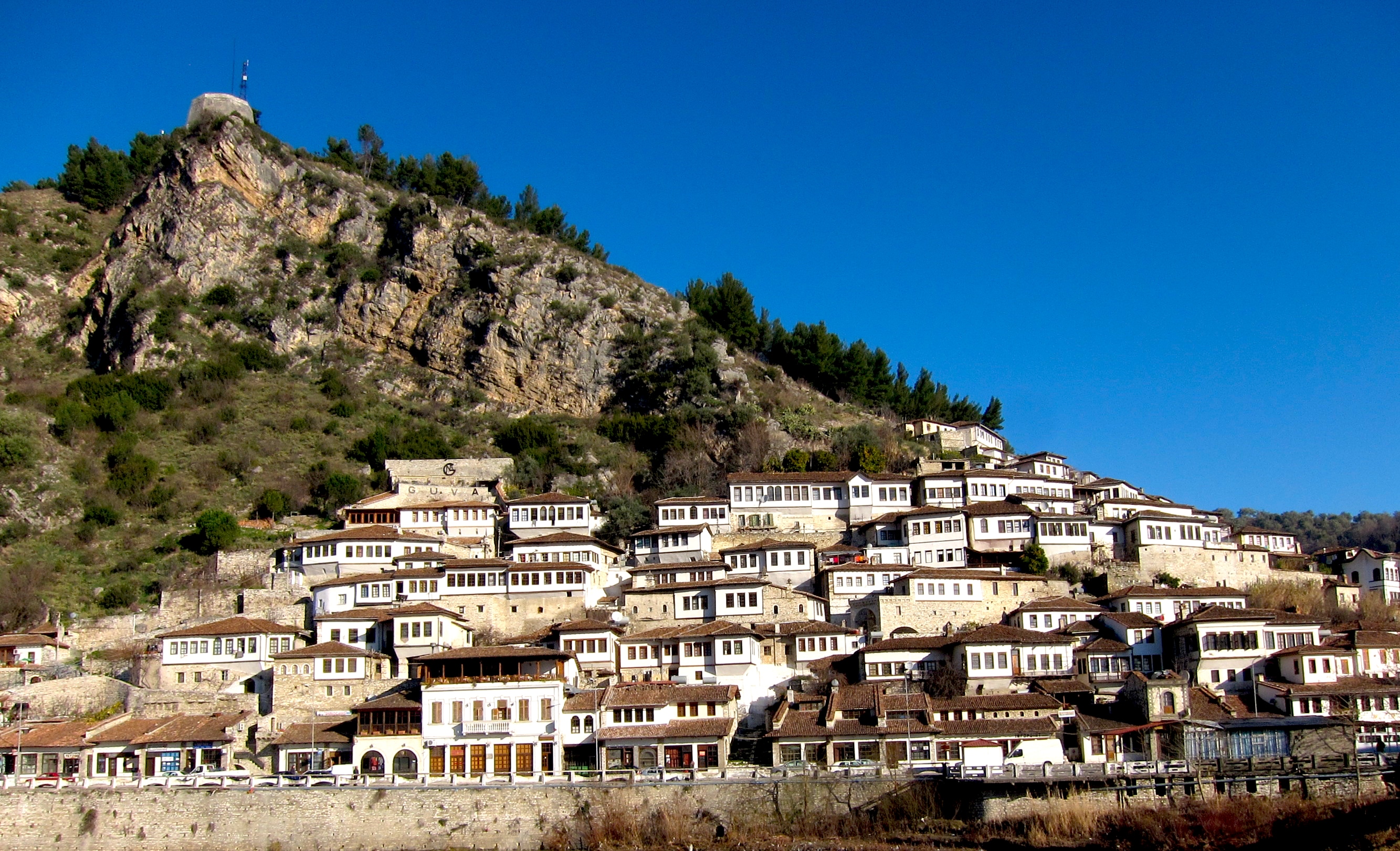Table of Contents
When you are in Berat there are plenty of things to do and see in this UNESCO Town. Below you can find our top things to see while visiting the town on your own.
The main sights in Berat are: the Castle, Mangalem quarter, Gorica quarter, and Medieval Centre.
The Castle of Berat
Berat’s beautiful old castle tops our list of the best attractions in Berat. It is located on the top of a hill, and it is the perfect place to admire the town from above. The small town inside the castle’s walls is one of the most enchanting places you’ll see in Albania. There are even a few people that still live there. The area looks magical with its ancient ruins, wildflowers, and small courtyards.
The castle is the oldest attraction in Berat with a surface of 9.6 hectare situated on a hilltop of 187 m high where you can easily spend two hours exploring it.
The castle has 24 protective towers built at different periods with squared shape stones. Albanian and foreign archeologist and historians who have studied the castle and excavated there, would put the construction of the castle back to the 4th century BC.
In fact the castle dates even earlier as an inhabitable place to the 6th- 5th century BC. The castle would change names continually since its beginning during the 4th century BC.
We learn that the castle was called Antipatrea or Antipagrai around 216 BC and Romans would call it Albanorum Oppidium.
Inside the castle you can see that it is still a living place with around 1000 inhabitants which by the way are not rich as some tourist would think.
From the fortified walls you can see the river Osum and one of the branched of Seman river which flows into the Adriatic. You can see as well parts of the old quarters of Mangalem, Gorica and the ottoman bridge from the 18 century build by Ahmed Kurt Pasha.
The castle during its existence has changed rulers from Illyrians, to Romans, Byzantine, Bulgarian, Serbs, Ottomans and Albanians.
Inside the castle today you can find two abandoned mosques such as Fetih Mosque built during the time of Sultan Byazit II and the Red Mosque build during the 15 century.
There are as well several churches which are not possible to visit and still hidden to the general public because of preservation constraints.
In the castle as you walk along the castle walls a big square shows in front of you where you are presented with the statue of Konstantin the Great, the Roman Emperor who had an Illyrian origin and was considered as well a protector of Christianity.
The encircling wall protecting the entrance of the castle from direct assaults, dates back to the beginning of the 13 century.
The castle has remained faithful to it original construction plan in the form of an arrow looking to the north. Later during the 17-19 century the castle was further adapted through the construction of towers for defensive purposes.
Before entering the fortification wall of the castle pay attention to the engrafting found on the top right of the door arch which puts the construction period in 1204 AD during the time of Michael I Komnenos Doukas.
As you enter the first encircling wall you will be presented with a second gate the foundations of which actually go to the 4th century BC.

What to visit inside the castle of Berat
St. Mary of Blachernae Church, Berat
The church of Saint Mary of Blachernae is one of the oldest surviving churches inside the castle of Berat. The name of the church is closely connected to the Byzantine Empire since we don’t find another church with the same name in Albania.
Based on the method of construction the church was built during the 13th – 14th century. This period of time corresponds with the rule of Michael I Komnenos Doukas who was the ruler of Epirus.
The second phase of construction which can be seen from the frescos adorning the church walls (1578) begun around the 16th century. During this phase of construction the roof was covered in wood after a devastating earthquake which did destroy the previous one.
The third phase of construction had to do with other restorations done to the church due to another earthquake happening in 1751.
During the 80’s Albanian archeologist discovered the remains of a previous church upon which was built the existing one which dates probably to the 6th century AD.
The church is an important monument of Byzantine architecture for the city of Berat since it is the first church of its kind in the city.
The Church of Saint Constantine and Helen, Berat
The Church of Saint Constantine and Helen was built in 1639 whereas the frescos were painted in 1649. The church was renovated in 1791 probably due to damages happen from an earthquake.
The frescos were painted by a famous local painter Onufër Qiprioti. Above the main entrance we can see a central seen from the “Assumption of Saint Mary” . The floor is paved with stone tiles and in the centre is a radial mosaic made of stones and square tiles.
Onufri Museum
Onufri National Museum is one of the must-see attractions in Berat Albania. It is located in the inner part of “Saint Mary Church” in Berat Castle. The Museum is called “Onufri” in honor of the Albanian painting Headmaster of XVI Century. The Cathedral was rebuilt in 1797, and it is the most representative monument of post-Byzantine architecture of the city of Berat. Within the museum you can find 173 objects out of a collection of 1500 objects belonging to the Albanian Churches and Monasteries fund. In the museum you can see 106 Icons and 67 Liturgical objects created by Albanian Iconographical painters during the XIV-XX centuries.
The date visible in the entrance door indicates that the church was rebuilt in 1797. The church of Saint Mary in which today we admire the Iconostasis and the other works of art, is one of the most representative monuments of Byzantine architecture in Berat. Everything inside the church, from the stone slabs composing the solar calendar to the amazingly carved iconostasis and skillfully painted frescos impart a visual conduit of the Christian afterlife.
The iconostasis as one of the most visible work of art inside the church-museum dates back to 1806 and is still preserved in excellent condition. Behind the iconostasis we can still see the frescos which could withstand the time and where in 1967 were found two rare Christian books we call the Codices of Berat.
Currently, the Cathedral houses the “Onufri” National Iconographic Museum where some of the most famous icons of Albanian artists have been collected from different churches in Berat and are now exhibited in this museum.

The Holy Trinity Church, Berat
Looking at this very proportional and nice rebuilt church it is impossible not to appreciate how seamlessly it integrates with the surrounding castle. Within the walls of Berat Castle is the extraordinarily beautiful Holy Trinity Church, an Orthodox church built in the 14th century. It stands beneath some inner castle walls overlooking windswept grasses and a great view of Berat and the surrounding vicinity.
The church of the Holy Trinity represents one of the most photographed churches of Berat. The byzantine architecture of the church and its inner organisation attests to a high level of construction with many decorative element. The church is located on the south side of the castle and holds a very panoramic position overlooking the valley of Osumi and Shpiragu mountain.
The church shape is in the form of a cross and it altar was built on top of a big rock with pillars and other construction elements from a previous construction period.
The frescos inside the church are mostly damaged due to humidity but you can still see certain scenes from the Bible such as Lazarus resurrection, Mystical dinner and the washing of the feet of the Apostles.
From the inscription preserved on the south entrance of the church we learn that the monument was built during the reign of Andronicus Palaeologus II (1282 – 1328).
The church was built with the special clausonage technique (combination of bricks and stones) which because it was expensive, was used only on the upper part of the construction.

The Red Mosque
The Mosque, noted as being built by of Sultan Bayazit, is mentioned by the Ottoman traveler Evlya Çelebi during his visit to Berat. He wrote “in the outer castle, which surrounds the inner castle, is a wide mosque covered with tiles, with a minaret, an archaic building with old grey stones.” The plan of the mosque includes the prayer hall, the portico, and the minaret built of tiles which have given to the monument the name “red”. The minaret is very interesting because it was built on the eastern part of the prayer hall and not on the western part as is common. Perhaps this can be explained by the proximity of the mosque with the perimeter wall of the castle, and building the minaret on the eastern part might have been a reasonable architectural solution. Judging by the second name attributed to the mosque, “Fetije Xhami” (meaning the “Mosque of the conquest) and from the same construction technique found in other mosques in Albania in the 15th century, it is thought that the Red Mosque belongs to the period immediately following the conquest of the Castle of Berat by the Ottomans, in 1417. But there are some other researchers who claim that the mosque belongs to the 14th century and is evidence of pre-Turkish Islam in the city.
Ethnographic Museum
This museum is one of the best attractions in Berat Albania. It is an 18th-century stone building with wooden beams and stairways that offers a fine overview of life in the city. There are plenty of artifacts on display related to the local artisan industry and domestic life. Among them are an authentic antique olive press and displays of ceramics that are hundreds of years old. Have a peek at the traditional textiles and costumes, as well as the methods used to weave them. A couple of rooms have been set up as traditional lounges or dining rooms, so you can imagine yourself as an Ottoman hundred of years ago.
Although not massive, this museum is very well designed. It has a number of rooms that give you an insight into what life was like in Berat. The helpful staff provides you the information in a number of languages.
Click here for some hotels near Ethnographic Museum which you can book if you want to spend some days exploring these attractions in Berat.
Medieval Centre
King’s Mosque

The King’s Mosque was built at the end of the 15th century and is otherwise known as Sultan Bayazit Mosque. Today’s mosque has changed gradually with the passing of time. So in 1832 the monument was about to be destroyed because of which had to be renovated completely.
The mosque stands near a complex of other buildings the cluster of which is known locally as the medieval centre.
Nearby you can visit the Helvetti Tekke, the library and the inn. North of the mosque the visitor can find two monumental graves skilfully built during the 17th century.
When you enter the mosque you will be welcomed by an opened portico which has its own mihrab (prayer place) facilitating in this way the prayer ceremony when the inner chamber was full of believers.
The outer part of the mosque was built at a later period from the inner part dating back to the 18th century.
Inside the mosque you can admire the amazing woodcarving done by Master Dush Barka were rosettes are inscribed with various Kuran writings.
The frieze below the ceiling contains the 99 names of God.
The Helveti Tekke
The Helveti Tekke was build during the 15th century and then later rebuilt by Ahmet Kurt Pasha in 1782. It belongs to the Helveti Sect. Basically a tekke is a monastery or a prayer house for the Dervish. They are different from other Muslim believers in that they belong to the Shia Group whereas the other believers who pray in a Mosque are mostly Sunni.
Berat is considered part of UNESCO Heritage even for the fact that several religious denominations both Christian and Muslim cohabit peacefully and in harmony with one another.
In the prayer hall is a mafil carved in wood and decorated. On the eastern side of the prayer hall is the mihrab decorated with stone stalactites.
On the inner walls have been painted in total 8 frescoes. The frescoes bear images of dwelling houses, Muslim religious buildings and natural sceneries.
The walls below the frescoes are covered by holes that improve the acoustics in the prayer hall.
The ceiling of the prayer hall is made of wood and is decorated with paintings valued as some of the most beautiful of the time. The ceiling has been decorated according to the Baroque style adopted in the Islam art and was covered with 14 carat gold plates.
The portico of the Teke has five has five stone columns which were taken from the antique city of Apollonia.
Bulevardi Republika
The Republica Boulevard is a pedestrian street that is parallel to the Osum River on the side of the Mangalem neighborhood. If one stands in front of the hill in the back you can see, on your right, parks and the river, and on the left a long line of shops, bars, and restaurants with their tables outside protected by umbrellas. It is a good place to shop or have a drink.

Dimal
In Berat yon can find the ruins of the ancient city of Dimal located near the village of Krotinë. Archaeologists discovered this fortified city with its mall, necropolis, houses, and the acropolis in the 1960s. This place is located on the right side of the road Fier-Berat in the municipality of Cukalat.
Tomorr Mountain
To the east of Berat is the Tomorr Mountain National Park, the highest peak of which soars to 2,416 meters. Most of the year snow caps this mountain range. If you’re holidaying in Berat in the summer then the high temperatures will make an ascent on foot difficult. If you would like to skip this challenge, hire a 4×4 to take you to the top. The route to the top is wonderful, passing olive groves, pine forest, and highland pasture before entering a stark landscape of exposed rock.

The Osumi Canyons
On our list of attractions in Berat is the Osumi River canyon. It is one of the most spectacular attractions of Albania. During the spring, water from melted snow raises the water level. This makes it possible to explore all 26 km of the canyon from the river. Spring is also the best time to view the waterfalls in the canyons, which flow from above as explorers pass below on boats.
The edges of the canyon are notable for their unique ecosystem that preserves the greenery on both sides of the canyon year-round. Mediterranean bushes like heath and briar flourish along with a rich and lively world of flora and fauna.

Nurellari Winery and Guest House
The Nurellari Winery is in a fantastic place with a fantastic landscape. It is a family run business that offers a variety of services. They offer wine tasting, vineyard tours they even have luxury accommodation on site.

Bogove Waterfall
The waterfall might be small but it is extra pretty. The waterfall has a rare beauty, and you can swim in the turquoise water pools. In the summer the water is cold, so it makes up for the heat you will endure to reach the waterfall.


0 Comment